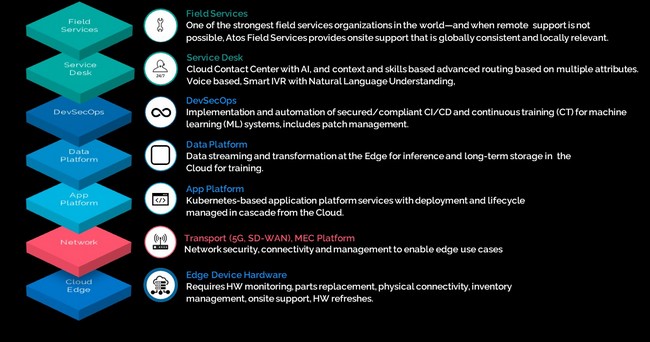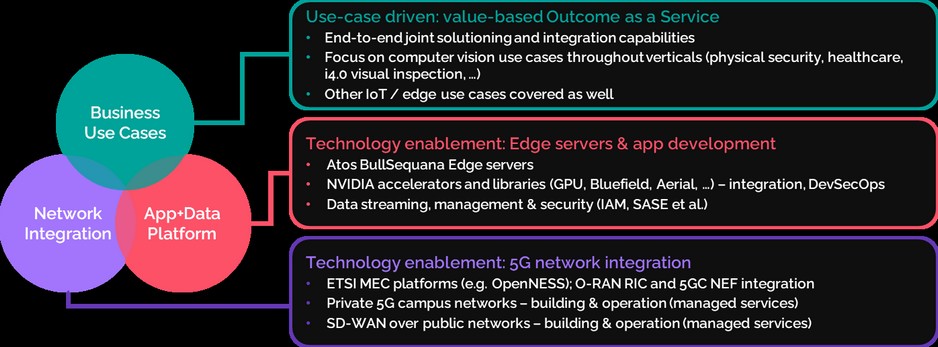Edge services: a new era of IT and telco business?
Is edge computing a myth, or the holy grail for telecom operators?
That was the question asked in a recent panel discussion organized by Red Hat. Indeed, the promise of edge computing is powerful. Digital transformation goes beyond the data center — it becomes distributed, networked and ubiquitous. Telco services are a key element of the new era, but what needs to be considered to make this digital transformation trend beneficial to every industry?
Let us look at multi-access edge computing (MEC) from three perspectives, as illustrated below:
Fig. 1: Three key aspects of MEC (multi-access edge computing)
 The business use case perspective
The business use case perspective
Technology innovations associated with edge computing and IoT are virtually endless, and focusing on a specific business purpose is even more important than in other areas of IT and OT.
What is the business outcome expected? What needs to be invested to achieve it? Can some combination of a telco, an IT solution and a managed service provider possibly provide the desired outcome?
Business purposes can vary. Imagine, for example:
- The metro train operator with a regulatory safety obligation, wishing to alert on people stepping down on tracks or into subway tunnels. (Ipsotek, an Atos company, recently built such an alert system for Sydney Trains.)
- The telecom operator introducing VSaaS (Video Surveillance as a Service) as a value-add offering to small/medium businesses and residential customers. The idea has been around for a long time, but edge-level video analytics now makes it economically feasible.
- The manufacturer periodically inventorying its warehouses and stockyards with camera-equipped drones.
It’s no accident that all three examples involve computer vision. Automated processing of video streams plays a role in almost every edge computing use case today, though not exclusively. Every so often a combination of video analytics and telemetry prevails, like for supervising physical integrity and operational parameters for energy grids and utilities. Sometimes telecontrol and other OT disciplines are added to the mix.
To produce significant ROI, a business use case requires not only technology – computer vision and other – but also a full stack of outcome-as-a-service components, including elements like a service desk or field services for the distributed MEC installation (see Fig. 2).

Fig. 2: The end-to-end outcome-as-a-service MEC stack
The application and data platform perspective
Application platform technology must be chosen wisely to serve the intended business purpose.
Wherever edge computing is involved, edge server hardware is a key element. A real edge server must be fit for purpose, factoring in temperature and humidity ratings, the size and form factor, and energy consumption. Attempts to deploy general-purpose data center servers on the edge often fail.
The other requirement is hardware accelerators to make edge computing more effective. Accelerators mostly come in the form of PCIe cards that support functionality like 5G network access and computer vision. In addition to the edge server operating platform, all hardware add-ons and middleware need to be certified with the edge server.
Specialized vendors have emerged for edge acceleration technology, supporting the deployment of edge-level artificial intelligence and machine learning (AI/ML). Application platforms can also encompass specialized software environments. IoT PaaS landscapes, for example, are numerous – and support continuous integration and deployment (CI/CD). Another most crucial aspect of edge application platforms is information security and digital sovereignty, as detailed here.
The network integration perspective
Network integration is another supporting factor to a business-driven edge computing strategy.
Special MEC platform software is the connecting element to 5G or other transport networks. Wide Area Networking (WAN) has long been looked down upon, but its days of just being a "dumb pipe" are over. Where edge computing is concerned, and distributed or networked digital transformation is taking place, communication is an important enabling technology. Today, 5G transport goes hand-in-hand with edge computing.
5G has some distinctive advantages over other edge transport networks. It is typically chosen when:
- Edge devices are mobile, such as online video cameras mounted on vehicles, boats or drones, or when Wi-Fi or LTE cannot provide adequate network quality for self-driving factory forklifts or automated cars
- The quantity or physical distribution of edge devices makes cabling too costly
- The outstanding quality of service features of 5G (like network slicing) are needed, which may even be superior to wired networks
- Time to production is of the essence, and pulling cables would delay the project too long
Many years ago, the ETSI (European Telecom Standards Institute) published a reference architecture for telco MEC that shows the proper edge application, but there are also central functions like MEC app lifecycle management or rules and rights management in the "MEC platform manager" on the right-hand side, cross-MEC-app orchestration, and integration with a telecom operator's OSS (Operations Support System).
One key function of MEC platform software is to furnish an interface for MEC applications to monitor the transport network and do traffic steering. Future MEC applications and transport will be tightly integrated, comprehensive solutions, giving the applications full control over their 5G slices and other networking.
Advanced 5G network functionalities are typically introduced in the context of mobile network modernization and 5G roll-out by telcos. Enterprises are increasingly establishing private 5G networks for their own business purposes, and advances in small-cell technology are paving the way for private campus 5G to eventually replace enterprise Wi-Fi.
Managed SD-WAN – an area where Atos has been active for several years – over public IP networks of any kind constitutes another important edge computing transport option. Edge computing ought to be multi-access, as the acronym MEC says.
Putting it all together
The real art of making edge computing a business reality in the 5G era lies in wisely combining the three factors described. Business-driven use cases and an outcome as-a-service perspective should take the lead, but application and data management platforms (including edge hardware, IoT PaaS and security) and telecom network integration are important technology enablers.
The market appears to be trending towards cooperation between telecom operators, hyperscalers and cloud/edge-savvy system integrators (which add vertical industry expertise).
Telecom operators and hyperscalers compete in many marketplaces, and the vertical solutioning experts can be the orchestrators needed to facilitate synergies and solutions – outcomes as-a-service – for end customers to achieve.
The market appears to be trending towards cooperation between telecom operators, hyperscalers, and cloud/edge-savvy system integrators.
By Franz Kasparec, Head of global digital infrastructure and cybersecurity offerings management in the telecommunications and media industries
Posted on: February 15, 2022
Atos can help harness the power of 5G for your business, your customers, and your stakeholders.
Visit our page on Atos 5G Real-time Enterprise to learn more: https://atos.net/en/lp/atos-5g-real-time-enterprise

 The business use case perspective
The business use case perspective